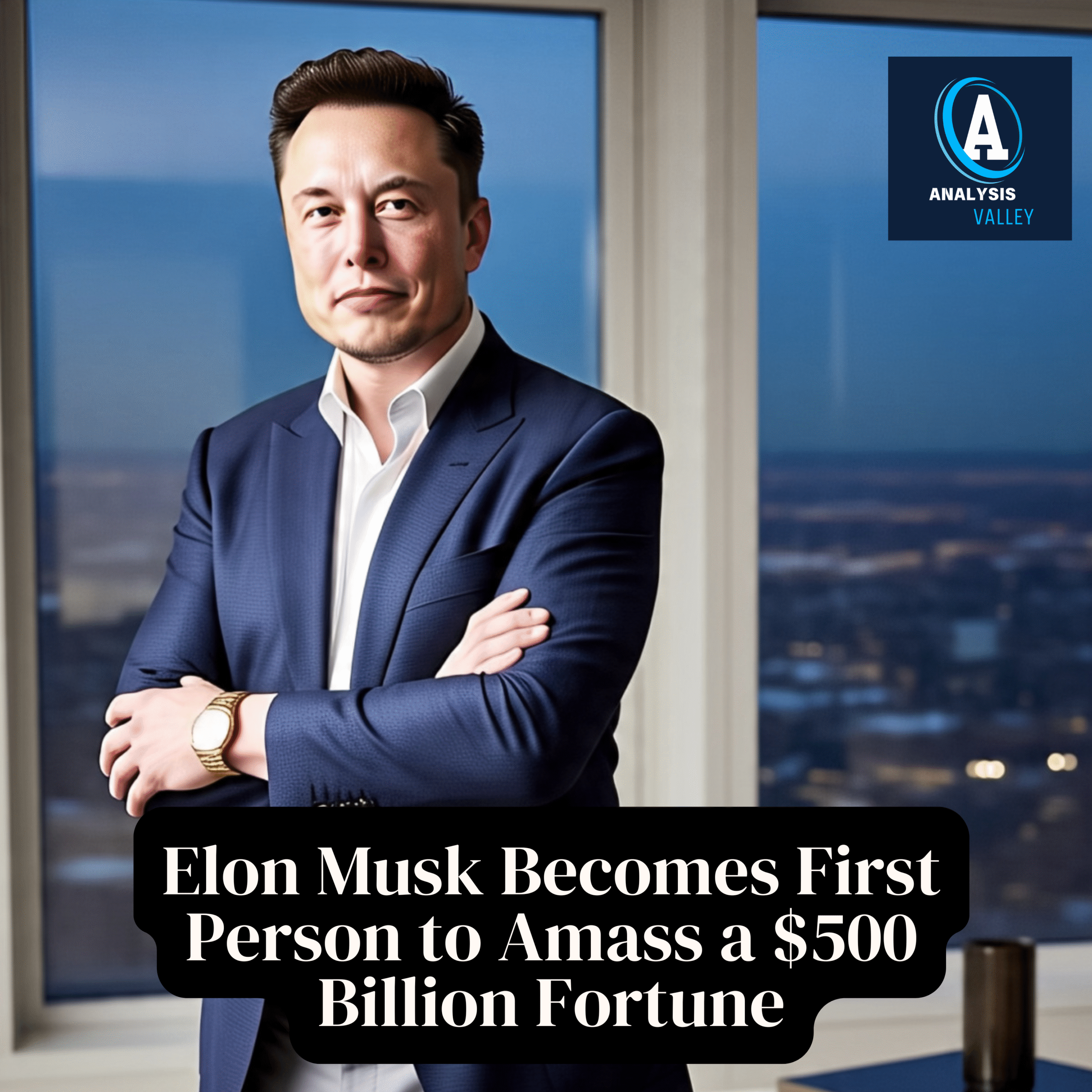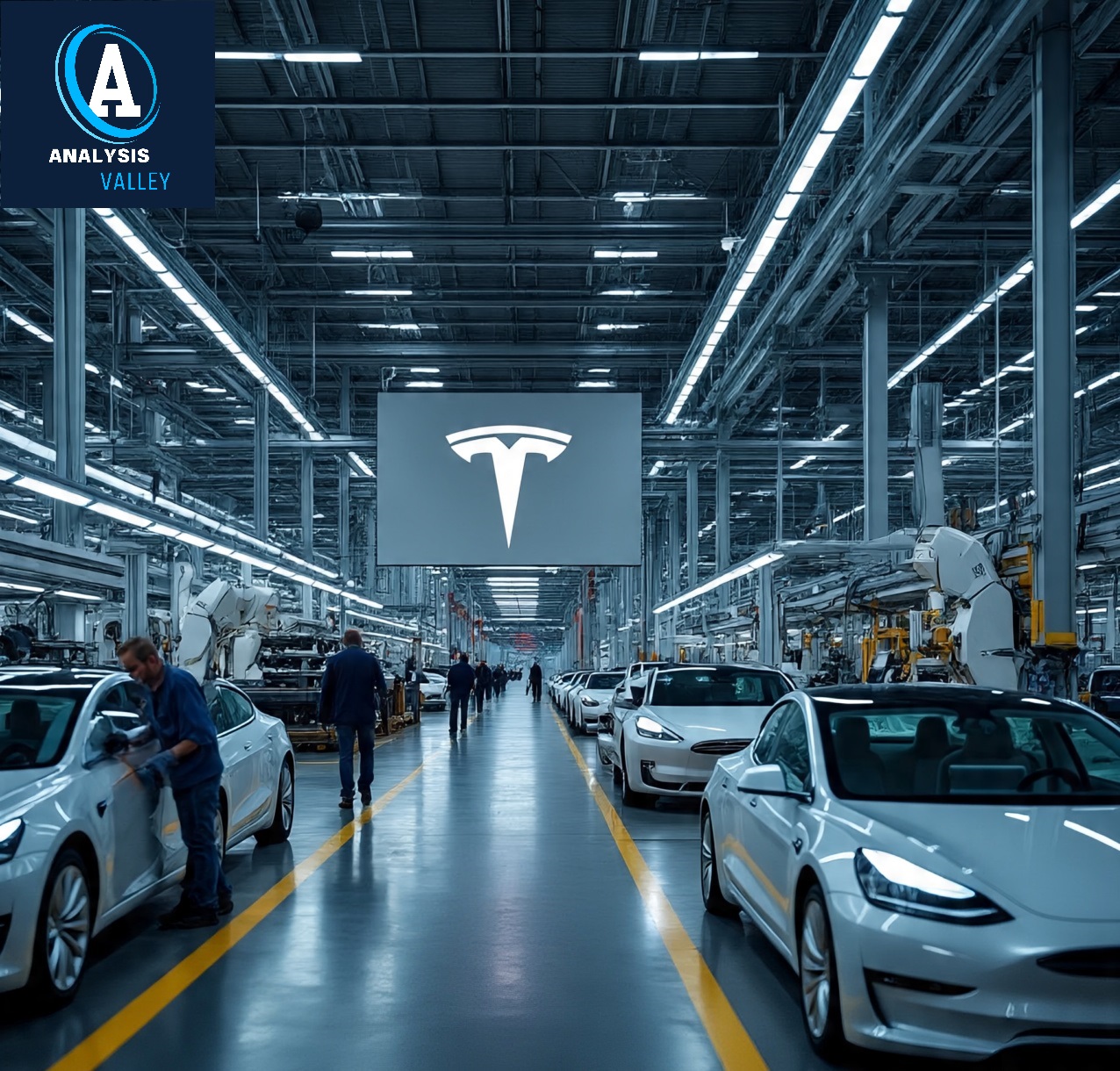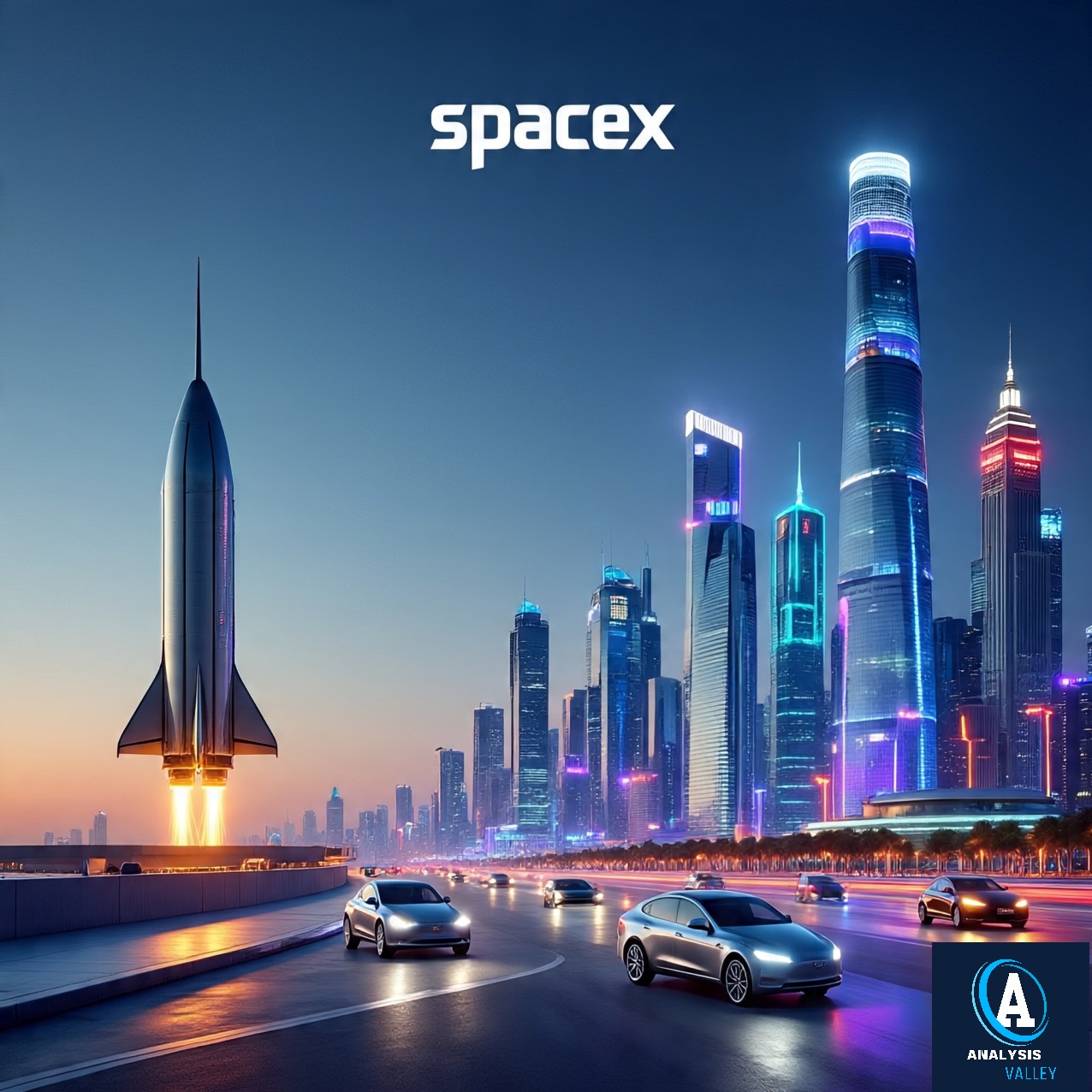AUSTIN, Texas – 1st october, 2025 – In an unprecedented milestone that recalibrates the very scales of modern wealth, Elon Musk net worth has officially surged past the $500 billion mark, cementing his status not merely as the world’s richest person, but as a financial entity in a class of his own. This landmark achievement, confirmed by data from the Bloomberg Billionaires Index and Forbes, was primarily fueled by a relentless, multi-day rally in Tesla stock, catapulting Musk into a financial echelon previously only theoretical in the annals of economic history.
The surge, which began in late September amid a flurry of bullish company news and culminated in a dramatic market opening this week, added over $50 billion to Musk’s fortune in a breathtakingly short period. This event transcends a personal financial record; it is a significant moment in economic history, reflecting the immense market power of disruptive technology, the fervor of retail and institutional investors, and the volatile, asset-driven nature of 21st-century billionaire wealth. It raises profound questions about economic concentration, the valuation of future potential, and the influence of individual visionaries on the global stage.
“We are witnessing a concentration of wealth in new industries that is rewriting the record books in real-time,”
“Musk’s ascent to $500 billion is less about liquid cash and more about the market’s sky-high valuation of future potential—specifically, in electric vehicles, autonomous driving, and space exploration. It’s a bet on a techno-future he is actively building. The figure is staggering, but the underlying narrative of innovation-as-an-asset is what truly defines this era.”
said, Dr. Anya Sharma, Senior Economist at the Global Institute for Wealth and Inequality.
The Anatomy of a Fortune: Deconstructing the $500 Billion Milestone
To comprehend the scale and nature of Elon Musk’s wealth, one must first abandon traditional notions of wealth being held in bank vaults or liquid securities. His fortune is a dynamic, interconnected web of ownership stakes in a constellation of companies he founded or leads. The recent explosion in value is almost entirely attributable to Tesla, Inc. (TSLA), which, despite his other ventures, comprises an estimated 60-70% of his net worth. Understanding this milestone requires a deep dive into the mechanics of the week’s events.
The catalyst for this historic peak was a perfect storm of positive market news that acted as a powerful accelerant on an already optimistic investor base.
- The Spark: Record-Breaking Deliveries: The initial trigger was Tesla’s Q3 global delivery report, released pre-market last Tuesday. The numbers were not just good; they were a blowout. Tesla announced production and delivery of over 550,000 vehicles for the quarter, crushing even the most bullish analyst forecasts by nearly 10%. This demonstrated remarkable resilience in the face of a sluggish global EV market, heightened competition, and ongoing supply chain anxieties. The report served as undeniable proof of Tesla’s operational excellence and its ability to scale production efficiently at its new Gigafactories in Texas and Berlin, which are now hitting their production stride.
- The Jet Fuel: A Bullish Wall Street Endorsement: Mere hours after the delivery report, the prestigious investment bank Morgan Stanley released a bombshell analyst note. They not only reiterated their “Overweight” rating but raised their price target for TSLA to a street-high of $400, a significant leap from previous projections. The rationale was twofold and deeply compelling to the market. First, the note expressed heightened confidence in the imminent commercial viability of Tesla’s Full Self-Driving (FSD) version 13 software, citing improved data from the expanding beta tester fleet. Second, it highlighted the “underappreciated meteoric rise” of Tesla’s energy storage division, which it projected would become a profit center comparable to the automotive division within five years.
- The Conflagration: A Short Squeeze and Retail Frenzy: The combination of fundamental strength (deliveries) and bullish future projections (Morgan Stanley) creatfed a textbook conditions for a market frenzy. A significant number of investors had been “shorting” Tesfla stock, betting on its decline. The rapid price increase forced these investors to buy back shares to limit their losses, a process known as a “short squeeze,” which added further rocket fuel to the ascent. Simultaneously, retail investors on platforms like Reddit and X (formerly Twitter), where Musk himself is an influential figure, piled in, creating a feedback loop of buying pressure.
As a result, Tesla stock skyrocketed by over 18% in a volatile, high-volume two-day trading frenzy. Given that Musk owns more than 20% of Tesla, according to the latest regulatory filing, each significant move in the company’s share price has a billion-dollar impact on his personal balance sheet. This single event added approximately $45 billion to his wealth from Tesla alone.

The Pillars of Power: A Deep Dive into the Musk Portfolio
While Tesla is the dominant engine, Musk’s wealth is a multi-planetary system, with other significant bodies exerting their own gravitational pull.
1. Tesla: The Colossal Core
Tesla is no longer just a car company. The market increasingly values it as a vertically integrated sustainable energy and artificial intelligence conglomerate.
- Automotive: The core business, now achieving massive scale with the Model Y and Model 3, and preparing for the next generation of affordable models.
- Software and FSD: This is the crown jewel and the key to Tesla’s future valuation multiples. The potential for high-margin, recurring revenue from a subscription-based autonomous driving service represents a software-like profit stream that traditional automakers cannot match. Every incremental improvement in FSD beta is seen as a step toward this trillion-dollar market.
- Energy Storage: This is the “sleeper hit” of Tesla’s portfolio. The Megapack, a utility-scale battery product, is seeing exploding demand as the global transition to renewables accelerates. With grids needing massive storage solutions, Tesla’s first-mover advantage and gigafactory-scale production position it to dominate this critical sector for decades.
2. SpaceX: The Silent Titan
SpaceX, while privately held, is a behemoth that provides a stable and immensely valuable foundation for Musk’s financial portfolio. Its valuation is not subject to the daily whims of the public market, but rather to periodic funding rounds that have consistently valued it higher.
- Launch Dominance: SpaceX’s Falcon 9 and Falcon Heavy rockets have achieved a near-total monopoly on commercial heavy-lift launches for satellites and NASA missions. Its reusability has driven down costs to a point competitors cannot match, making it the default choice for global space access.
- Starlink Profitability: The Starlink satellite internet constellation has moved from a capital-intensive project to a profitable, cash-flow-positive business. With over 2.5 million subscribers and deals with governments and airlines, Starlink has proven its commercial and strategic value, creating a global communications network.
- The Starship Gambit: Starship represents the future. A fully reusable orbital-class rocket could reduce the cost of access to space by orders of magnitude, unlocking new markets from space manufacturing to asteroid mining and, ultimately, the colonization of Mars. Investors see this not as science fiction, but as a defensible technological moat that justifies its colossal private valuation, as tracked by Forbes in real-time.
“SpaceX has effectively lapped its competition not by a year, but by a generation,” “With Starship, they are building the logistical infrastructure for the next era of the space economy—an internet-of-things in orbit, lunar bases, and beyond. That potential is almost limitless, and it directly contributes to the Elon Musk net worth narrative in a way that is unique among his peers. It’s a bet on him as a modern-day industrialist.”
said, Laura Chen, Managing Partner at Stellar Venture Capital
3. The Supporting Cast: xAI and The Boring Company
- xAI: Musk’s artificial intelligence startup, launched as a competitor to OpenAI, has already attracted billions in funding. While still a minor part of his net worth, its potential is vast. If xAI achieves a fundamental breakthrough in Artificial General Intelligence (AGI), it could instantly become his most valuable asset.
- The Boring Company: Focused on tunnel construction, it continues to secure contracts for urban loop transportation systems. While its contribution to his wealth is smaller, it exemplifies his approach to solving infrastructure problems and adds another layer to his portfolio of future-facing companies.

A Financial Stratosphere Uncharted: Contextualizing the Incomparable
The number $500,000,000,000 is so vast it becomes abstract, requiring stark comparisons to ground it in any tangible reality. Analysts, economists, and journalists have scrambled to find analogies that capture its scale.
- The GDP Comparison: Musk’s personal net worth now exceeds the annual Gross Domestic Product (GDP) of entire, developed nations like Norway ($435bn), Austria ($480bn), and Thailand ($495bn). This means the resources he controls, on paper, are greater than the total economic output of these countries for an entire year.
- The Billionaire Benchmark: His fortune is roughly equivalent to the combined net worth of the next two richest individuals on the planet: Bernard Arnault, the patriarch of the LVMH luxury goods empire, and Jeff Bezos, the founder of Amazon. This gap is unprecedented in the history of the Bloomberg Billionaires Index.
- The Temporal Scale: If Musk were to attempt to spend his fortune at a rate of $1 million every single day, it would take him nearly 1,370 years to deplete his current fortune, not accounting for any interest, investment growth, or additional wealth creation.
- The Corporate Equivalency: His wealth is greater than the individual market capitalization of corporate giants like Johnson & Johnson, Visa, or Procter & Gamble.
This extreme concentration of wealth inevitably reignites intense debates around economic inequality, the power of individuals to shape public and global policy through their wealth, and the structure of tax systems that favor unrealized capital gains. Unlike a salary or dividends, the increase in Musk’s wealth is not a taxable event until he sells shares. This fact is central to the ongoing, heated discourse about wealth taxes and how modern billionaires are—or are not—taxed on their paper gains.
The Engine Room: A Technical Analysis of Tesla’s Meteoric Rise
To understand Musk’s wealth, one must become a student of Tesla’s stock. The company’s recent performance is a masterclass in how narrative, fundamentals, and market mechanics can combine to create a valuation supercycle.
1. The Fundamental Pillar: Unmatched Execution
The Q3 delivery report was more than a number; it was a statement. In a quarter where competitors like Ford and General Motors were scaling back their EV ambitions due to slowing demand, Tesla accelerated. This demonstrated a powerful brand moat and production prowess that competitors cannot easily replicate. The success of the Gigafactories in Berlin and Texas is particularly critical, as it localizes production for key markets, insulating Tesla from trade tariffs and supply chain disruptions.
2. The Software S-Curve: The FSD Factor
The single most significant variable in Tesla’s valuation model is the progress of Full Self-Driving. The Morgan Stanley note tapped directly into this. The market is beginning to price in the probability of “Level 4” autonomy—where the car can handle all driving tasks in most conditions without human intervention. The potential revenue from this is manifold:
- Subscription Fees: A monthly fee of $100-$200 from millions of Tesla owners would create a recurring revenue stream with near-90% profit margins.
- Robotaxi Network: Musk’s long-held vision of a network of owner-operated robotaxis, where Tesla takes a 20-30% cut of every ride, would transform the company’s revenue model entirely.
- Licensing: The possibility of licensing the FSD software stack to other automakers is another potential, massive revenue source.
Every incremental software update that shows smoother handling of complex “edge cases” in driving brings this future closer to reality, and the market reacts accordingly.
3. The Energy Juggernaut: Beyond the Car
While the automotive division grabs headlines, Tesla’s energy business is quietly becoming a behemoth. The Megapack, a container-sized battery unit for utilities and large businesses, is sold out for the next two years. The global push for grid modernization and the intermittency of solar and wind power create an almost insatiable demand for large-scale storage. Tesla’s ability to produce these at scale in its dedicated Megafactory gives it a commanding lead in a market that is essential to the global energy transition.
The Inherent Fragility: Volatility and Vulnerability in a Paper Empire
For all its breathtaking scale, the architecture of Elon Musk’s net worth is inherently fragile. The same concentrated holdings that propel his wealth to record highs also make it uniquely vulnerable to rapid, catastrophic declines. History is littered with examples; in late 2022, his fortune dipped below $130 billion during a broader tech sell-off and a tumultuous acquisition of Twitter.
The risks are multifaceted and ever-present:
- Key Person Risk: Musk is Tesla and SpaceX. Any significant health issue, a prolonged period of distraction (as seen with the Twitter acquisition), or a major controversy stemming from his social media activity can immediately erode investor confidence and trigger a sell-off.
- Regulatory and Legal Threats: A serious Autopilot-related accident leading to a massive recall, a formal investigation into FSD claims by the SEC or DOJ, or a significant regulatory setback for Starlink in a key market could have immediate and severe valuation consequences.
- Execution Failure: A failed Starship test flight that results in a prolonged launch pad closure at Boca Chica, a critical defect found in a new batch of Tesla vehicles, or a significant delay in the promised “next-gen” affordable car could all break the narrative of flawless execution.
- Macroeconomic Shocks: As a growth stock, Tesla is highly sensitive to interest rates. A return to a high-rate environment by the Federal Reserve to combat inflation could depress the present value of its future earnings, leading to a major multiple contractions.
- Capital Needs and Share Sales: Musk periodically sells large blocks of Tesla stock to fund his other ventures, particularly SpaceX, and to cover tax obligations on expiring stock options. These planned sales can temporarily depress the stock price and incrementally reduce his overall holdings. A large, unexpected sale could spook the market.
“The volatility is a feature, not a bug, of this kind of wealth,” “The market isn’t just valuing Tesla as a car company anymore; it’s valuing it as a vertically integrated energy and AI company. This means it trades on future narratives. Narratives can change in an instant. A $100 billion drop in his net worth in a bad week is not just possible; it’s probable at some point. The same forces that propel him upward can work in reverse with terrifying speed.”
said, Michael Thorne, Chief Market Analyst at Crestview Financial.
The Ascent to a Trillion: Charting the Uncharted Territory
With the $500 billion barrier broken, the once-unthinkable question now seems almost inevitable: could Elon Musk become the world’s first trillionaire? The path to a twelve-figure net worth is no longer pure fantasy but a scenario that depends on the successful maturation and commercialization of his most ambitious projects. Analysts have begun to model out what this would require.
- Scenario 1: The Tesla Robotaxi Dominion. This is the most direct path. For Musk to reach a $1 trillion personal net worth, Tesla’s market capitalization would likely need to approach $4-5 trillion (accounting for his other assets and potential share dilution). This valuation would require the full-scale, global deployment of a profitable robotaxi network. If Tesla can convert even a fraction of its fleet and capture a dominant share of the global mobility-as-a-service market—a market estimated to be worth trillions—this scenario becomes plausible. The shift from selling cars (a low-multiple business) to selling mobility (a high-multiple, software-driven business) would trigger the greatest re-rating of a stock in history.
- Scenario 2: The SpaceX IPO and the Space Economy. While SpaceX is private today, many analysts expect a public offering for its Starlink division within the next few years, or for the entire company later this decade. An IPO of Starlink, a profitable, global telecom with first-mover advantage in low-earth orbit, could instantly create a public company worth hundreds of billions. If the Starship program is successful and begins regular flights, unlocking the space economy, the combined value of a public SpaceX could easily exceed $1 trillion. As the majority owner, this would single-handedly push Musk across the trillion-dollar finish line.
- Scenario 3: The xAI Wild Card. Artificial Intelligence is the ultimate wild card. If xAI achieves a fundamental advance that challenges OpenAI and Google’s DeepMind, or achieves a milestone towards Artificial General Intelligence (AGI), its value would be incalculable. It could spawn a new, multi-trillion dollar company almost overnight, dwarfing even his other holdings.

A New Gilded Age: The Broader Implications for Society and Economy
Elon Musk’s financial achievement is a defining symbol of a new, digitally-driven Gilded Age, dominated by technology magnates whose influence extends far beyond the economy into geopolitics, social discourse, and humanity’s long-term future. His control over critical infrastructure—from global communication (Starlink) to transportation (EVs) to the future of space access—grants him a level of soft power historically reserved for nation-states.
This concentration prompts profound questions about accountability, governance, and the social contract in the 21st century.
- The Philanthropy Question: Unlike historical figures like Andrew Carnegie or John D. Rockefeller, who dedicated their later years to large-scale philanthropy, Musk’s charitable giving, through his Musk Foundation, has been modest relative to his wealth. The world is watching to see if and how he will deploy his vast resources to address global challenges like climate change, disease, or poverty on a scale commensurate with his fortune.
- The Policy Influence: With great wealth comes great influence. Musk’s views on AI regulation, free speech, and energy policy are now amplified by his financial stature. His ability to move markets with a tweet, or to provide or withhold critical technology like Starlink in geopolitical conflicts, places him in a unique and powerful position between the public and private sectors.
- The “Muskonomy”: Some economists have begun to speak of a “Muskonomy”—a segment of the global economy that is directly or indirectly influenced by his companies and investments. This includes not just Tesla and SpaceX, but the entire EV supply chain, the battery industry, the satellite telecom sector, and the AI research field.
As his companies continue to push the boundaries of technology, the world will be watching not only the price tags attached to his ventures but also the societal impact of having a single individual command resources rivaling those of major countries. The $500 billion figure is more than a number; it is a Rorschach test for our collective hopes and fears about technology, capitalism, and the future.
For now, the number stands at over $500 billion. It is a figure that marks a historic first, a testament to radical ambition and relentless execution, and a powerful catalyst for a global conversation about wealth, power, and the shape of the world to come.
— Reporting by Analysis Valley News Desk. With contributions from our financial and technology correspondents.

